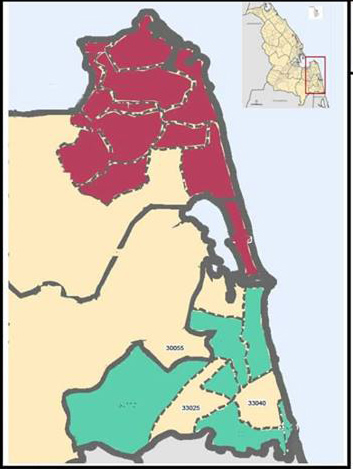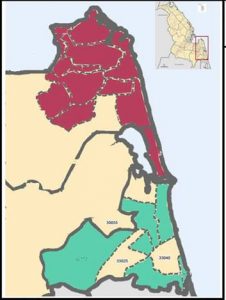Return of the IDPs to Echeilampattu AGA Division in Trincomalee District
The second half of year 2006 saw the entire population along the eastern coast of Trincomalee (see map both red and green areas) pushed to Batticaloa as the result of military offensives. Indeed the people along the coast further south of the area in the map were also pushed down. This report is about the resettlement of the people thus pushed out and we are using the highlighted area in the map for our case study. The situation will be the same for the people further south who were also pushed out and are now being resettled.
areas displaced multiple times as they were continuously pushed down all the way into the south of the Batticaloa district. Indeed at some stage the population thus pushed down was trapped in a narrow strip of land caught between the fighting units of the LTTE and the Sri Lankan armed forces. The death and injury t on these civilians during this period remains unrecorded due to the chaos of displacement. The resettlement started in early 2007 in the mids of accusations that the IDPs were being forcefully resttled
the displaced people their own land. According information filed by local Member of Parliament, R Sampanthan, a total of 15600 people were living in this area. Just a few weeks ago, ahout 300 people from one GS division, Pallikudiyiruppu, of this area was brought back, however, accusations were leveled that they were being settled in very infertile undesirable land
The people from the Eechilampattu AGA division loo are slowly returning to their home from the IDP camps in Batticaloa. This report is based on the experiences of the retumed IDPs in Eechlampattu (green area in map)
The pcople in this area are cither farmers or lishermen. Only handul of people follow other profcssions. When these peple displaced, e fishere lesl behind heir mosl valuable possession the boat and the nets. Indeed the fishermen were already affected by the 2004 tsunami and they lost everything a second time when they displaced due to the military offensive. The farmers lost livestock, another major source of income. Many farmers recounted thc sizc of thcir herds that thcy lost when thcy displaccd. On rcturn thcy also tound their home ully or partly deslroyvd and their farmn cquipment also missing
It is with this kind of loss that the resettled IDPs are attempting to restart their livelihood Many of them are frustrated by the impediments they are facing in their efforts. The fishermn arc facing restrictions. In somc popular placcs of rich fishing resources thcrc is a total han on lishing sucl as the lankaith and Vcruhal jetly
The richest farmlands beloning to these people are along the Veruhal river at the southern border of this AGA division. The farmers are still barred from cultivating these vast paddy fields. People also complained that they are unable to fence their fields to keep away the animals that destroy the cultivation. The Sri Lankan Army, they say cuts fences to make their movement easy with no regard to the farmng effots of the people
These people take their livestock into the forests for gracing. They also depend on the collection of firewood. honey, and other forest products. If the military sees anyne in the forest they shoot without asking questions. Therefore people are unable to also use the forest resources. As result of these restrictions people said that they are effectively living on relief provided by the NGOs rather than rebuilding their livelihoud
People also said that they have been ordered not to refer to the llankathurai Muhathuvaran a GS division n their area by its name. Instead they were told to refer to it as Lankapatnam, a Sinhala name Some of the people said that they were beaten by the military for using the original name
Fear is also forcing the people to observe an undeclared curfew after 6.00pm. This gives an idea of the fear of the military among the resettled people. Indeed, people said that most of the young people of their community did not return to their homes and have instead chosen to go clsewhere, learing tary
The military calls for a meeting approximately once a month in their villages. Everyone is expected to go for the meeting, even the sick and the mothers with newborn babies. In these meeting the people are warned of not to associate with the LTTE and to inform the military if thev Iearn of anv infiltration by the LTTE
-North East Secretariat on Human Rights

